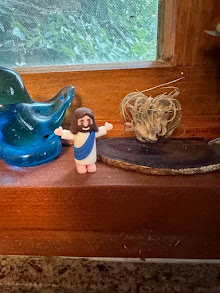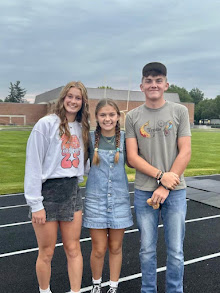
Back from New Mexico, from one of the centers of civilization for North America. We wandered amid the volcanic debris of Petroglyphs National Monument, reading the blurbs on the trailposts, purporting to explain via the experts what each picture meant to the creator. What really made some of our fellow humans perch out on that sharp black scree slope, laboring stone upon stone to leave animals, monsters, swirls, faces, arrows and other unknown creative scribbles. We didn't follow every trail, but there is no hospitable shady spot nearby, no protected cave or shade tree. Nothing but geology writ large, a canvas of stone spread over several square miles and media built to take whatever Mother Nature can dish out. You want a lasting impression? Try basalt.
I am always intrigued by art of the past, and the older the art, the more piquant the notion of the continuity of humanity, the similarities outweighing the differences, much like the genetic blueprint of all beings varies a surprisingly small amount. Here is a macaw; here is a goose. Even I admit that this interpretation is not a stretch. How often did a macaw appear in the markets of these people? Once in a lifetime? Every week? Was the bird memorialized for posterity like comets and other celestial outrages have been through recorded history? Or are the pictures art for art's sake, the outpouring of creativity hardwired into human beings before we could write.
If these folks had lived anywhere less harsh, we wouldn't be able to speculate and admire their pictures today.
This is also the land of ancient churches, formed of the earth, arched, curved, leaning this way, buttressed that. With reredos and emaciated saints gazing from deep set piercing painted eyes. The carved beams are black with age and the benches are narrow and hard. One church is surrounded by a low adobe wall, planted with a hedge of Russian sage. There are adobe wells beneath each of the six rain chutes. A two foot tall stalk of corn grows in singular splendor in a stone ring. The chapel is beautifully maintained and the altar retablos and santos in their niches beckon with medieval gestures. Another chapel has almost impossibly primitive wooden towers, but new construction and landscaping lead from the gravel parking area (with room for tour buses) to the church. A lovely mural graces the restrooms. One can buy lunch and gifts and crafts a short distance from the church. Inside, the black eyed saints still demand attention, respect for their age, and the palpable devotion of the visitors and worshippers alike. A traveler files through a room with discarded crutches and passes one where there is a hole of holy dirt. In Santa Fe, the oldest chapel, that of San Miguel, can only be accessed, in time honored fashion, by passage through the gift shop. The weathered exterior is surrounded by scaffolding and we gladly donate to continue its maintenance and renovation. These churches are silent during our visits. Most request no photography, though no signs to that effect are visible at San Miguel. The loneliest chapel we visit is in a village on the high road to Taos. The late afternoon mountain sky is full of clouds and darkens the facade of the locked building. Weeds are growing beneath one tower through the adobe and the effects of age and weather are brutally obvious. This church dates from the 18th century, and while it is the most evocative of the landscapes, it is a sobering reminder of how much money and labor it takes to keep the lovely old structures in use. This is not just history, because history is part of the past. These churches are living like a giant oak or redwood is still living, even though the world of their youth is almost unimaginable to us moderns.
The Southwest evokes these emotions from visitors routinely. We react to the unadorned landscape, the scarcity of vegetation, the clarity of light, the way even our human structures here seem to grow directly from the soil itself. It attracts artists, there's no doubt, whether attracted by the physical attributes or the metaphysical. Sometimes music just comes out of the air and your toe taps to unheard songs; in New Mexico, the beauty is so close to the surface, but so deeply rooted, that it grows on the rocks.















No comments:
Post a Comment